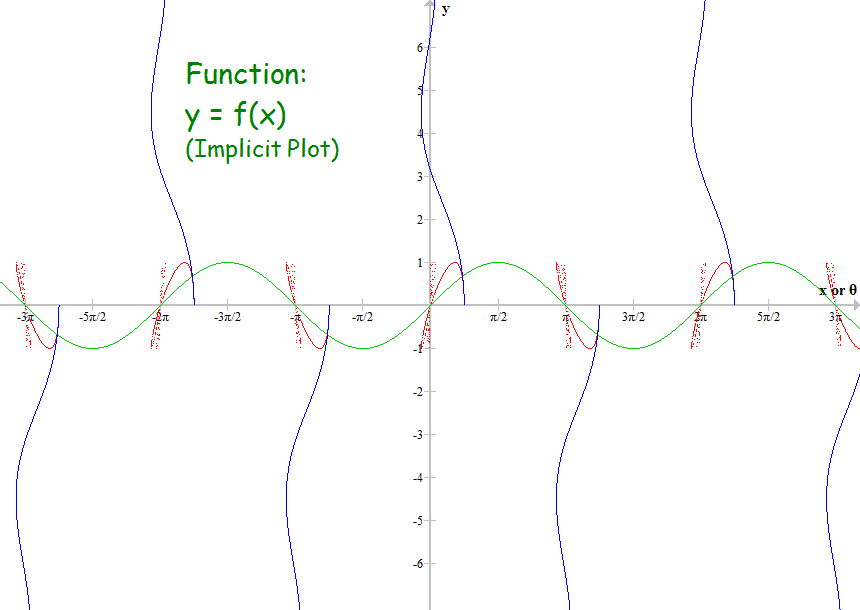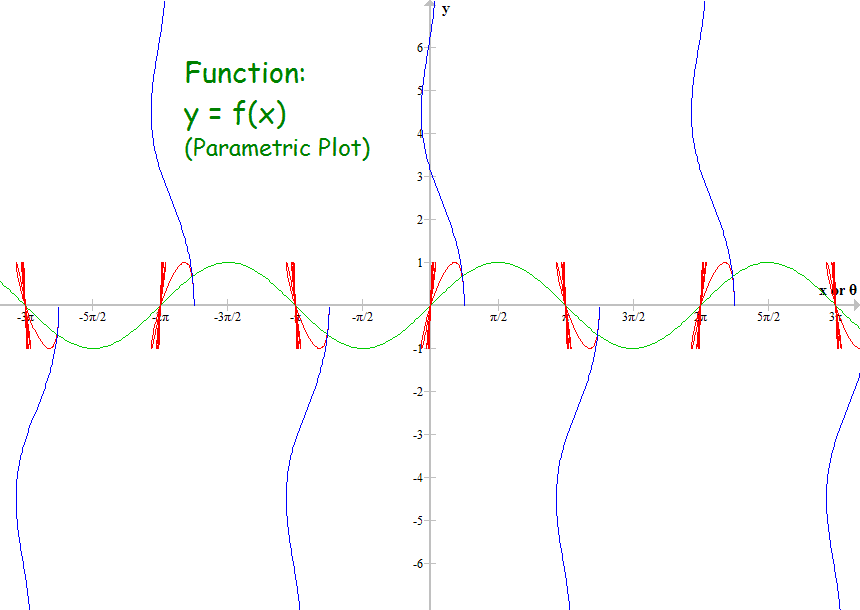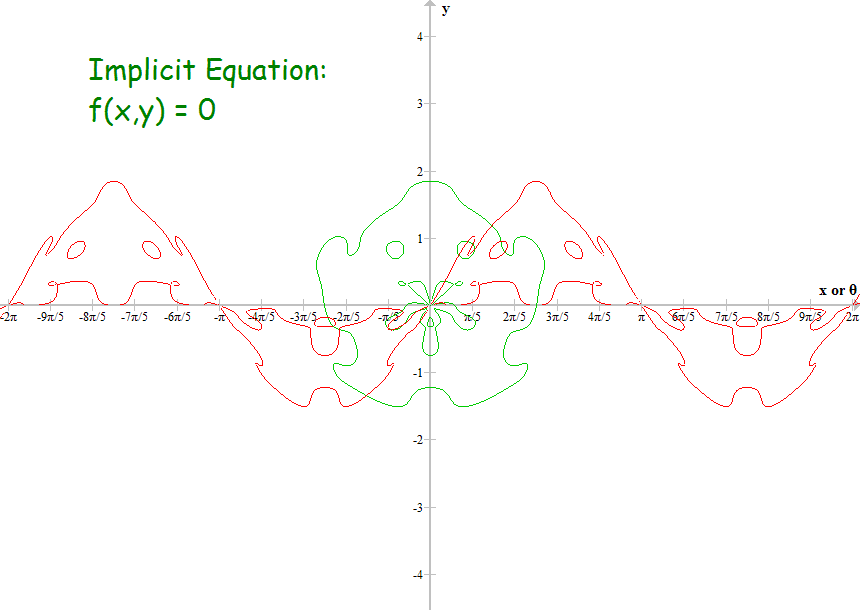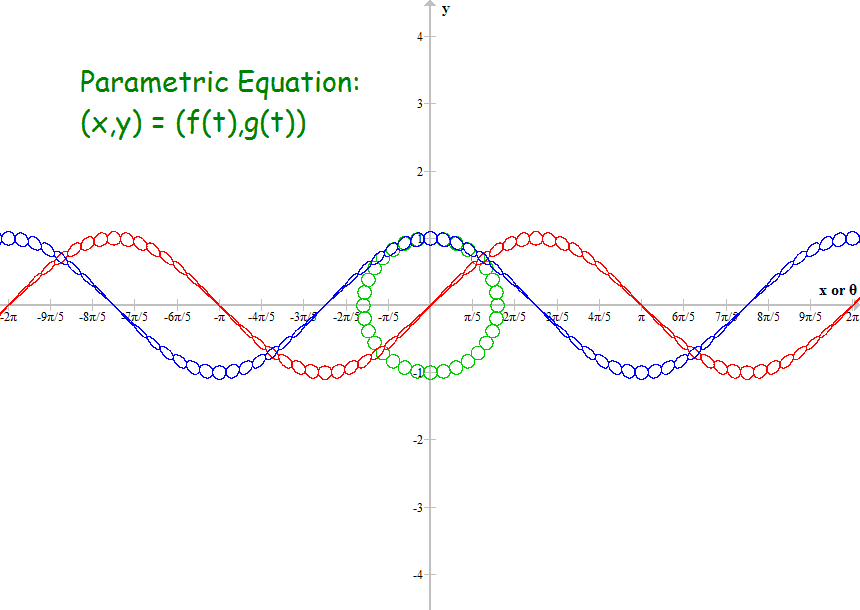Math Is Fun Forum
You are not logged in.
- Topics: Active | Unanswered
Pages: 1
#1 2014-06-22 03:37:26
- Maburo
- Member
- From: Alberta, Canada
- Registered: 2013-01-08
- Posts: 287
Tracing a Function
Say we have the unit circle and we take any point on it and connect a line from the origin to that point, marking the angle
from the horizontal axis to the line. We then rotate the line around the circle, varying the angle and plot the height of the point on the circle above the horizontal axis, . Plotting the value of for every angle gives us the sine function, .What if, instead of a unit circle, we traced an ellipse? We would make a line from the origin to a point on the ellipse, noting the angle
between the horizontal axis and the line, then varying and plotting the height above the horizontal axis, , for corresponding values of x. So, we apply the same process of obtaining the sine function from the unit circle on other shapes.I have absolutely no background in programming, so I have not been able to have a computer generate these functions for me. I imagine that if we did this to an ellipse, we would get a sine function stretched out along the x-axis.
But what if we did this to any function like a polynomial, rational, exponential, logarithmic, sinusoidal, or even parametric or polar? I'm not sure how to find out what these would look like, as I do not know any programming languages (although I have used Maple a bit).
I can only try to imagine what some of the simpler ones may look like. For example, an ellipse should look like a sine function stretched along the x-axis. The polar function
should look like a cycloid with every other arch missing.I would like to know if anybody who can program something like this could show me what some graphs generated this way look like? Or maybe there is a way to define these functions so I can graph them myself? If anybody knows anything about curves generated this way, or could show me what some look like, I would be very interested to hear/ see what you have!
"Pure mathematics is, in its way, the poetry of logical ideas."
-Albert Einstein
Offline
#2 2014-06-22 04:37:31
- bobbym
- bumpkin

- From: Bumpkinland
- Registered: 2009-04-12
- Posts: 109,606
Re: Tracing a Function
Hi;
There ain't a whole lot Maple can not do. Got a couple of images to show?
In mathematics, you don't understand things. You just get used to them.
If it ain't broke, fix it until it is.
Always satisfy the Prime Directive of getting the right answer above all else.
Offline
#3 2014-06-22 04:48:59
- Maburo
- Member
- From: Alberta, Canada
- Registered: 2013-01-08
- Posts: 287
Re: Tracing a Function
I don't have any images because I do not know how to generate them. I have, however, found a link to a dynamic image of the sine function (and cosine) being generated by tracing the unit circle. What I want to do, though, is put the point on any function or curve and trace out the resulting curve in the same way.
"Pure mathematics is, in its way, the poetry of logical ideas."
-Albert Einstein
Offline
#4 2014-06-22 05:00:12
- bobbym
- bumpkin

- From: Bumpkinland
- Registered: 2009-04-12
- Posts: 109,606
Re: Tracing a Function
HI;
Sorry, my version of Java is not up to seeing that applet. But if it is there then Geogebra can do it.
In mathematics, you don't understand things. You just get used to them.
If it ain't broke, fix it until it is.
Always satisfy the Prime Directive of getting the right answer above all else.
Offline
#5 2014-06-22 05:41:58
- anonimnystefy
- Real Member

- From: Harlan's World
- Registered: 2011-05-23
- Posts: 16,049
Re: Tracing a Function
Hi Maburo
The equation you are looking for is:
where a and b come from the equation of the ellipse:
Here lies the reader who will never open this book. He is forever dead.
Taking a new step, uttering a new word, is what people fear most. ― Fyodor Dostoyevsky, Crime and Punishment
The knowledge of some things as a function of age is a delta function.
Offline
#6 2014-06-22 05:50:23
- Maburo
- Member
- From: Alberta, Canada
- Registered: 2013-01-08
- Posts: 287
Re: Tracing a Function
Indeed! That's what I am looking for, for an ellipse. Now what if we did this with some other function?
"Pure mathematics is, in its way, the poetry of logical ideas."
-Albert Einstein
Offline
#7 2014-06-22 05:55:21
- anonimnystefy
- Real Member

- From: Harlan's World
- Registered: 2011-05-23
- Posts: 16,049
Re: Tracing a Function
Well, an ellipse isn't exactly a function, but, it can be done, I'd say. It would be very complicated in some cases.
Here lies the reader who will never open this book. He is forever dead.
Taking a new step, uttering a new word, is what people fear most. ― Fyodor Dostoyevsky, Crime and Punishment
The knowledge of some things as a function of age is a delta function.
Offline
#8 2014-06-22 05:56:49
- Maburo
- Member
- From: Alberta, Canada
- Registered: 2013-01-08
- Posts: 287
Re: Tracing a Function
How about something simple, like
. Of course, there will be some places where this will be undefined."Pure mathematics is, in its way, the poetry of logical ideas."
-Albert Einstein
Offline
#9 2014-06-22 06:05:47
- anonimnystefy
- Real Member

- From: Harlan's World
- Registered: 2011-05-23
- Posts: 16,049
Re: Tracing a Function
For that, it would be
Last edited by anonimnystefy (2014-06-22 06:06:21)
Here lies the reader who will never open this book. He is forever dead.
Taking a new step, uttering a new word, is what people fear most. ― Fyodor Dostoyevsky, Crime and Punishment
The knowledge of some things as a function of age is a delta function.
Offline
#10 2014-06-22 06:11:30
- Maburo
- Member
- From: Alberta, Canada
- Registered: 2013-01-08
- Posts: 287
Re: Tracing a Function
Ah, indeed it is. How are you finding this? And could you do it for
?"Pure mathematics is, in its way, the poetry of logical ideas."
-Albert Einstein
Offline
#11 2014-06-22 06:23:59
- anonimnystefy
- Real Member

- From: Harlan's World
- Registered: 2011-05-23
- Posts: 16,049
Re: Tracing a Function
That one isn't solvable, I'd say. At least in terms of elementary functions.
What I am doing is just taking
and substituting it into the given equation and solving for y.
Here lies the reader who will never open this book. He is forever dead.
Taking a new step, uttering a new word, is what people fear most. ― Fyodor Dostoyevsky, Crime and Punishment
The knowledge of some things as a function of age is a delta function.
Offline
#12 2014-06-22 06:45:27
- Maburo
- Member
- From: Alberta, Canada
- Registered: 2013-01-08
- Posts: 287
Re: Tracing a Function
Ah, I see. It should be
. This works! Thank you for your help.There are still many functions you could do this to where the resulting graph will not be solvable with elementary functions. However, they can still be drawn. Are you able to have a computer draw these?
"Pure mathematics is, in its way, the poetry of logical ideas."
-Albert Einstein
Offline
#13 2014-06-22 06:54:25
- anonimnystefy
- Real Member

- From: Harlan's World
- Registered: 2011-05-23
- Posts: 16,049
Re: Tracing a Function
Yes, sorry.
I think they can be drawn.
Here lies the reader who will never open this book. He is forever dead.
Taking a new step, uttering a new word, is what people fear most. ― Fyodor Dostoyevsky, Crime and Punishment
The knowledge of some things as a function of age is a delta function.
Offline
#14 2014-06-26 00:20:40
Re: Tracing a Function
However, they can still be drawn. Are you able to have a computer draw these?
Case 1: Polar functions r = f(θ)
Use a function grapher to plot
y = f(θ)*cos(θ) in θ-y plane.
Case 2: Implicit equations f(x,y) = 0
Use an implicit equation plotter to plot
f(y*cot(θ), y) = 0 & y/sin(θ) > 0 in θ-y plane.
Case 3: Parametric equations (x,y) = (f(t),g(t))
Use a parametric curve plotter to plot
(θ, y) = (atan2(g(t),f(t)), g(t)) in θ-y plane.
Case 4: Functions y = f(x)
Let g(x,y) = y - f(x) and see Case 2
or let (x,y) = (t,f(t)) and see Case 3.
All these cases can be done using Graph or gnuplot.




Last edited by benice (2014-06-26 01:01:30)
Offline
#15 2014-06-26 02:11:57
- Maburo
- Member
- From: Alberta, Canada
- Registered: 2013-01-08
- Posts: 287
Re: Tracing a Function
That is very interesting. Did you plot both y with θ and x with θ? For example, in your first plot, the blue curve was the distance along the x axis for corresponding values of θ, and the red curve was for distance along y axis?
Thanks for sharing!
"Pure mathematics is, in its way, the poetry of logical ideas."
-Albert Einstein
Offline
#16 2014-06-26 03:16:16
Re: Tracing a Function
Did you plot both y with θ and x with θ? For example, in your first plot, the blue curve was the distance along the x axis for corresponding values of θ, and the red curve was for distance along y axis?
Yes, blue for x and red for y.
The function used in the first two plots is y = sin(x).
The equation of the monster in the third image is here.
The ring of green circles in the last image can be expressed as follows:
x = cos(t-mod(t,s)) + r*cos(n*mod(t,s))
y = sin(t-mod(t,s)) + r*sin(n*mod(t,s))
r=0.1, n=32, s=2*pi/n,
t=0...2*pi.
Offline
#17 2014-06-26 03:45:50
Re: Tracing a Function
That's excellent!
What is your favorite color?
By the way, do you use Sage and POV-Ray tracer? If you use any ray-tracer, then which is your favorite?
'And fun? If maths is fun, then getting a tooth extraction is fun. A viral infection is fun. Rabies shots are fun.'
'God exists because Mathematics is consistent, and the devil exists because we cannot prove it'
I'm not crazy, my mother had me tested.
Offline
#18 2014-06-26 03:56:04
- Maburo
- Member
- From: Alberta, Canada
- Registered: 2013-01-08
- Posts: 287
Re: Tracing a Function
Amazing. How do you trace the curve in order to plot the distances corresponding to θ?
"Pure mathematics is, in its way, the poetry of logical ideas."
-Albert Einstein
Offline
#19 2014-06-29 15:26:00
Re: Tracing a Function
What is your favorite color?
The color of fresh air.
By the way, do you use Sage and POV-Ray tracer?
No, but I know Sage and POV-Ray are great free tools.
How do you trace the curve in order to plot the distances corresponding to θ?
I don't need to trace the curve in order to plot it. The software do the work for me.
If you use Graph or gnuplot, you can see this page for examples of parametric plots.
Graph can help you trace parametric curves. Select the parametric function you want
to evaluate or trace, and then press Ctrl+E. See this page for more details.
Offline
#20 2014-07-04 02:21:52
- Maburo
- Member
- From: Alberta, Canada
- Registered: 2013-01-08
- Posts: 287
Re: Tracing a Function
Thank you for sharing, benice. This is cool!
"Pure mathematics is, in its way, the poetry of logical ideas."
-Albert Einstein
Offline
Pages: 1